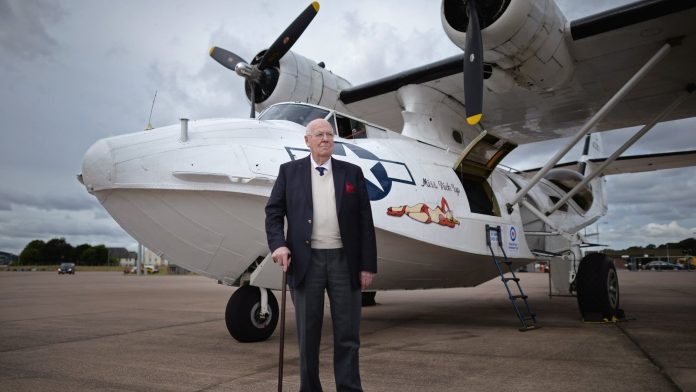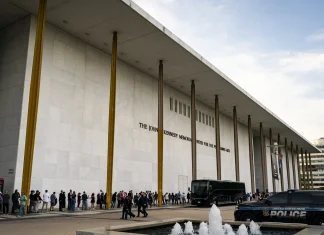
The Last Hero of a Vanishing Breed: Remembering Flight Lieutenant John Cruickshank, VC
When Flight Lieutenant John Cruickshank passed away last week at the remarkable age of 105, the world bid farewell to more than just a man—it said goodbye to the last living bearer of Britain’s most prestigious wartime honor: the Victoria Cross from the Second World War. But Cruickshank’s story is not merely that of medals and missions; it’s a vivid testament to courage under fire, a quietly heroic life marked by duty, resilience, and an understated humility that defines a generation now slipping slowly into history.
From Aberdeen to the Skies Above Norway
Born in Aberdeen, Scotland, John Cruickshank’s journey was one that many young men of his era shared—a calling to serve during a conflict that enveloped the globe with terrifying intensity. Yet, his story shines with unique brilliance. In July 1944, at just 24 years old, he captained a Catalina flying boat for the Royal Air Force’s 210 Squadron from RAF Sullom Voe on the rugged Shetland Islands, tasked with a mission that would etch his name into military lore.
That day, the skies above Norway became a battleground. The British Home Fleet was returning from a daring strike against the German battleship Tirpitz, and Cruickshank’s patrols had to ensure no lurking menace—particularly submarines—threatened the fleet’s safe passage. Soon enough, a German U-boat surfaced, a deadly predator in the chilly northern waters.
The Clash Above the Fjords
Imagine yourself in the cockpit, the cold Arctic wind swirling around the exposed window frames of a WWII-era flying boat, the weight of responsibility pressing like a physical force. The first attempt to neutralize the U-boat failed—the bombs stubbornly refused to release. But Cruickshank didn’t flinch. Ignoring the hailstorm of enemy fire, he turned the aircraft to face the threat head-on, preparing to strike again.
His second attack was successful—depth charges dropped with unerring precision, sinking the enemy beneath the dark waters. But victory came at a terrible cost.
He was grievously wounded—72 injuries in total. Two lung wounds, ten wounds to his legs, shrapnel, and burns. His navigator was killed instantly, while three crew members bore wounds so severe they are hard to imagine today. The aircraft itself was badly damaged, saturated with fumes from exploding shells, threatening to choke the survival from the tiny group.
And yet, laying down his painkillers, Cruickshank refused to surrender. Instead, he left the cockpit briefly but returned, directing the second pilot who had taken over. For more than five hours, they battled physical agony, mechanical peril, and nerve-rending skies, before finally bringing the crippled aircraft home. Even when he lost consciousness multiple times, he roused himself to help with the landing, a harrowing hour-long feat of wills.
A Quiet Hero’s Reflection
One might expect such an ordeal to be the stuff of dramatic legend, yet when interviewed in 2013, Cruickshank spoke of the mission with remarkable modesty.
“It was just normal,” he said. “We were trained to do the job and that was it. I wouldn’t like to say I’m the only one with an amazing story—there are plenty of others from that time. It wasn’t wonderful then; we just hoped for better days.”
That calm pragmatism carries the weight of an entire generation’s unspoken bravery—the countless acts of courage and sacrifice that rarely made headlines, but shaped the course of history. His story invites us to ponder: how do ordinary people become heroes? And more so, in what ways do they carry that heroism throughout the quieter chapters of their lives?
From War to Peace: A Banker’s Road
After the guns fell silent and the skies cleared, Cruickshank returned to civilian life—not with fanfare, but with steadfast persistence. He resumed his career in banking, a world far removed from the turbulent skies above Norway yet equally demanding in its own right.
But even in peacetime, his deeds echoed; his Victoria Cross stood as a symbol of courage and duty, a reminder of the cost of freedom.
Legacy of the Victoria Cross
During the Second World War, 181 men received the Victoria Cross, Britain’s highest award for gallantry. Each tells a story of extraordinary bravery and sacrifice, yet Cruickshank was the last survivor of this heroic group. What does it mean to witness, firsthand, the passing of a living link to such history?
It underscores a painful truth—those who lived through the crucible of global conflict are few, and with them go the immediate memories of sacrifice that shaped the modern world. The responsibility to remember, to honor, and to learn increasingly falls on us, the inheritors of their legacy.
The Shadows and Light of War
John Cruickshank’s tale also invites reflection on the broader human experience of war: the interplay of terror and bravery, loss and survival, pain and perseverance. It asks us to recognize the individual stories nestled within grand historical narratives—people who were not heroes because they sought glory, but because they answered a call greater than themselves.
In today’s world, where conflict and uncertainty still lurk in many corners, his life reminds us of the enduring value of duty, humility, and resilience. Could we face adversity with such calm resolve? Would we rise for others even as our own strength falters?
Honoring the Last of His Kind
Cruickshank’s family has chosen to hold his funeral privately, respecting his nature—a man who acted out of service rather than desire for recognition. Yet his story deserves public remembrance, a tribute to a century-spanning life that witnessed unimaginable change, yet remained tethered to principles that never age.
As we reflect on Flight Lieutenant John Cruickshank’s journey, let us carry forward his quiet fortitude, honoring not only his deeds but the spirit of those who lived by courage’s demands without fanfare. Their legacy challenges us all: to cherish peace, to remember the price of freedom, and to find strength in unwavering commitment to one another even in the darkest skies.









